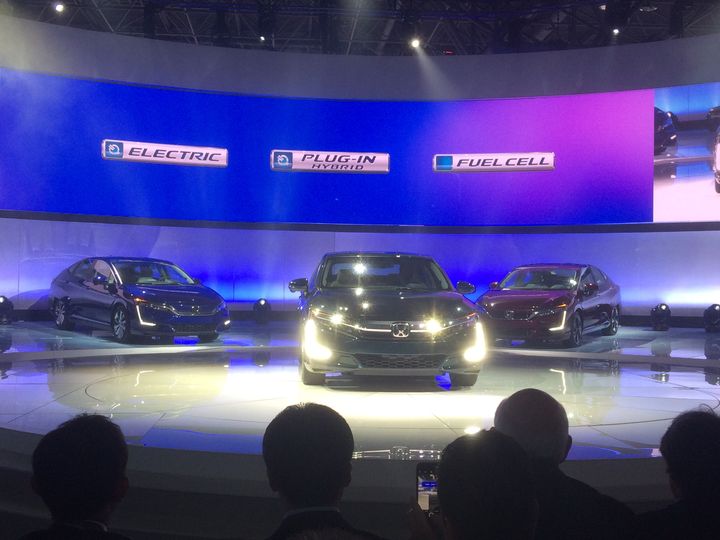
From L to R: 2017 Honda Clarity Electric; 2018 Honda Clarity Plug-in Hybrid; 2017 Honda Clarity Fuel Cell. Photo: Shane Kite
Most automakers extolled covetous, nearly Trumpian enthusiasms for raw power and prestige with the new vehicles they unveiled at this year’s New York International Auto Show.
A notable few opted for practical, even progressive ideals. And they stood out, like steady beacons in flickering starlight.
The humble handful included Honda, which on Wednesday reaffirmed its commitment to fuel cells, which generate electricity and zero tailpipe emissions via a circuit through which hydrogen travels to mix with oxygen. The Japanese carmaker called the mechanisms the optimal format to satisfy car buyers’ ecological and performance demands. The statement came during the world debut additions of a 2017 battery electric and 2018 plug-in hybrid to Honda’s Clarity line of eco-friendly sedans, which launched first with a fuel-cell-based model four months ago in California.
“For the long-term, we continue to believe that fuel cell technology has the greatest potential to address society’s energy and environmental concerns while better serving the needs of customers in terms of driving performance, range and refueling,” said Steve Center, VP of Honda’s connected and environmental business development office.
The Clarity fuel cell gets 366 miles between refills, which take three to five minutes. Fuel cell electric vehicles (FCEVs) in general offer longer ranges, provide more power in smaller, lighter packages, and allow users to refuel in minutes versus hours, compared to battery electric vehicles (BEVs). The fully electric Clarity, for instance, goes 80 miles before requiring a recharge. But that takes over 3 hours via a 240-volt charger (or 30 minutes for an 80-percent recharge with a DC fast charger).
However, there is only one network of public hydrogen fueling stations in the U.S.:so far - the 31 pumps currently working in California, although planning remains underway for a Northeast H2 corridor. The world’s largest network is in Japan, which has 82 stations .
Tune This!
Honda also unveiled its Civic for “tuners,” the 306-horsepower Civic Type R, which Jeff Conrad, SVP of the automobile division at American Honda, called “the fastest, most powerful Honda ever sold in the U.S.” Although the sport compacts are being assembled in Britain, Conrad was quick to point out that the Type R’s 2.0-liter, turbocharged “VTEC” engine is “made right here in America,” specifically at Honda’s Anna, Ohio, engine plant.

Honda’s Civic for tuners. photo: Honda
Toyota trumpeted the practical and populist too, invoking “America’s heartland” to describe its plant in Princeton, Ind., the point of assembly for the Toyota Sienna, the nation’s top-selling minivan for the last two years. The minor refresh for the 2018 model year includes now standard pedestrian detection and USB ports in all three rows of seats.
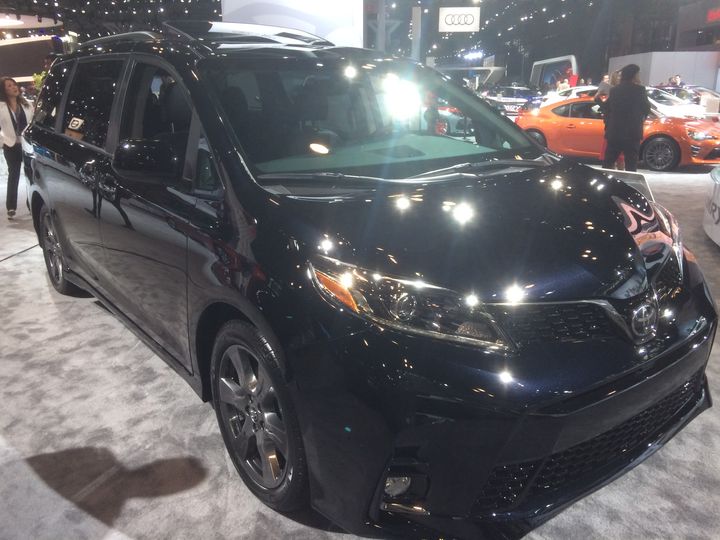
2018 Toyota Sienna debuts at NYIAS. Photo: Shane Kite
The 2018 Toyota Yaris also made its debut at Manhattan’s Jacob Javits Center. The French-built, budget subcompact, which received a redesigned, sporty front fascia, now comes standard with Siri “Eyes Free” commands for voice-based map routing and wireless music streaming.
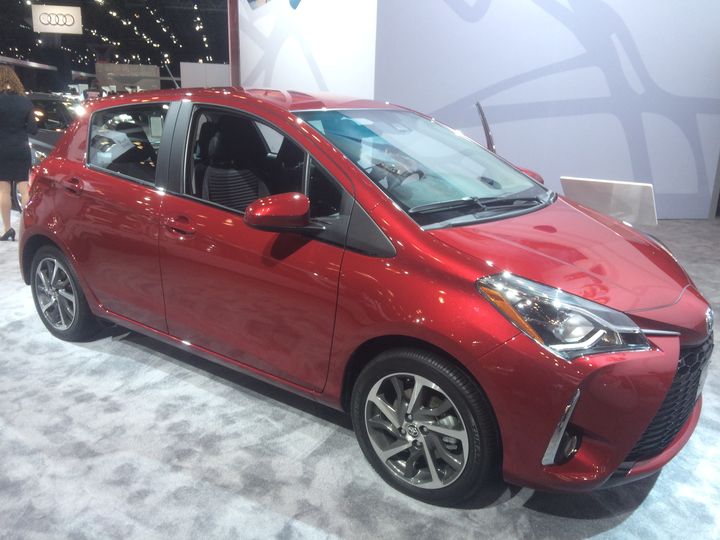
The 2018 Toyota Yaris. Photo: Shane Kite
Upstaging both cars at Toyota’s exhibit space, however, was the 2018 Camry, which debuted in Detroit in January. Ho-hum, you say? Well, the Camry has long been the most popular car in the U.S.: selling over 400,000 units per year in the states alone. This affordable, mid-sized sedan also consistently places in the top ten globally for best-selling vehicles.
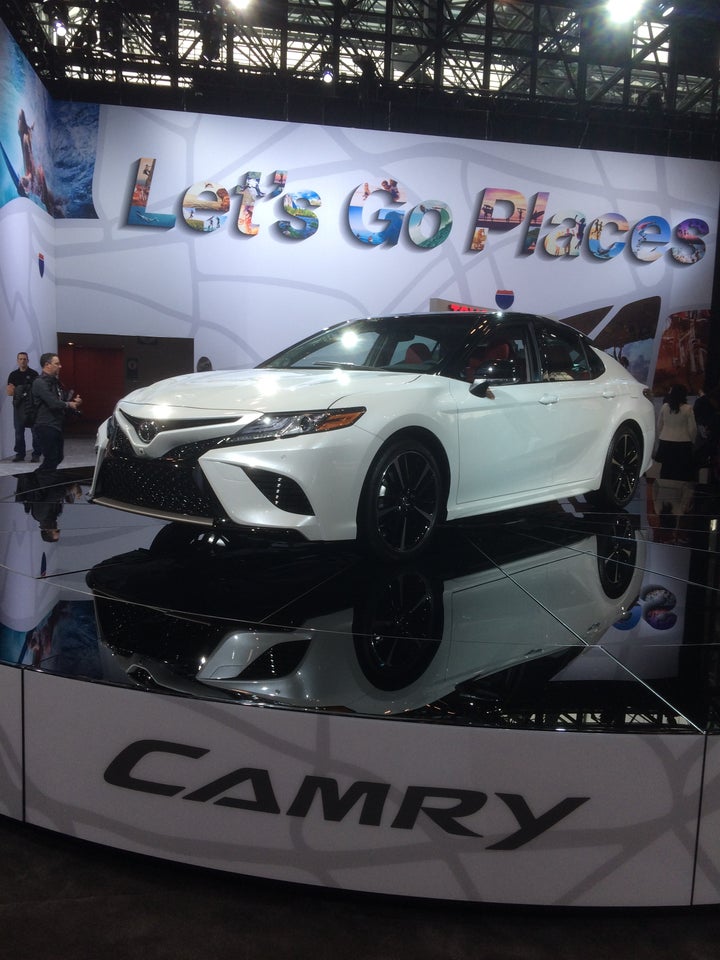
Photo: Shane Kite
Skip to the Fun Part!
But full-blast bombast predominated: And while the awesome, unceasingly astounding capabilities of shiny, bold, new machines are always celebrated at big OEM reveals, this year’s New York event offered some truly jaw-dropping, over-the-top affairs.
Center stage in this category was Jeep’s 2018 Grand Cherokee TrackHawk, with the aptly named “Hellcat” engine: a massive 6.2-liter, 707 horsepower V8 that rockets this 5,363-pound brute from zero to 60 mph in just 3.5 seconds. That’s half-a-second faster than a Porsche Boxster Spyder. The engine and supercharger weigh 800 pounds - 15 percent of the TrackHawk’s 2.7 tons. All that weight makes its brakes, well,... important, especially considering this nearly 3-ton monster’s top speed is 180 mph. Big exposed, yellow Brembo calipers stop the truck in 114 feet from 60 mph, an attribute repeatedly emphasized by the division of Fiat Chrysler Automobiles’ (FCA’s) North American subsidiary.
The aptly named Mike Manley, head of the Jeep brand, called the 2018 Hellcat TrackHawk “the most powerful, quickest SUV ever.” It is, he added, “the ultimate performance SUV.”

A 6.2-liter, 707 HP “Hellcat” Engine Powers the Jeep Grand Cherokee TrackHawk from 0 - 60 mph in 3.5 seconds. photo: Shane Kite
While not everyone is suited for TrackHawk extremes, U.S. drivers continue to show nearly insatiable demand for trucks: SUVs and pickups remain the most profitable segment for most automakers.
That’s precisely why nearly all carmakers are building SUVs. That includes Alfa Romeo, which has built a storied history specializing primarily in sports and race cars.
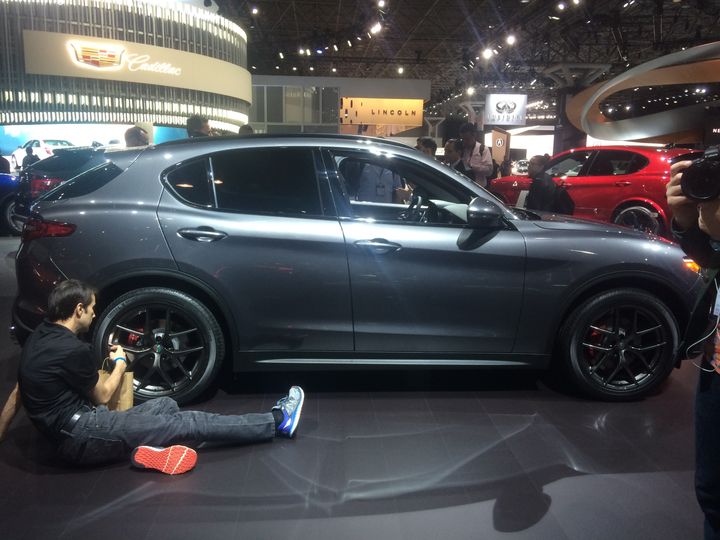
Attendee checks tire size of 2018 Alfa Romeo Stelvio, meant to broaden appeal of Italian automaker’s SUVs. Photo: Shane Kite
The Italian automaker, which is also owned by FCA, introduced the 2018 Stelvio, and Stelvio Ti, to North America at the New York show. The two trims are aimed at expanding the appeal of Alfa’s new SUV line to more mainstream U.S. buyers from those of the Quadrifoglio, an ultra-performance version of the SUV which debuted last fall in L.A.
Meant to combine lux Italian craftsmanship with sporty performance and all-weather capabilities, the Stelvios are equipped with the same “Q4” all-wheel-drive system that comes standard on the Quadrifoglio, albeit spun by a smaller 2.0-liter, direct injection, turbo 1-4 engine. Paired to an eight-speed automatic transmission, the more conventional trim levels produce a still vigorous 280 horsepower and 306 pound-feet of torque. The middle trim Stelvio Ti offers larger 20-inch wheels and 12-way power leather seats via a “Sport” package. Finer leathers and real wood accents can be had in the “Lusso” package.
Panache
Much like former repertory player Fred Armisen said as “Mike” on the SNL sketch, “Mike & Toni's Chandelier Galaxy,” Jaguar Land Rover’s introduction of its new Range Rover Velar, was: “bursting with class!” A tiny dog rested at the feet of an erudite woman. Strings pealed and champagne glasses clinked, as the British luxury sub of Tata Motors provided the perfect bubbly compliments at Velar’s North American premiere. It all felt very... British, in spite of the Hell’s Kitchen locale.

Gerry McGovern, Chief Design Officer (far left), and Dr. Ralf Speth (right, red tie), CEO, of Jaguar Land Rover, at Velar’s N. American debut. photo: Shane Kite
The Velar is so British, in fact (how British is it?!): It has wool seats! Regardless, the Coventry-based company seems to have a stateside hit on its hands: Hardened critics have professed love for this rakish SUV, with many predicting Range Rover fans will buy up the Velar to the point it becomes a U.S. fave. A good assumption, as there’s a bit of the Anglophile in most of us. (Think: James Bond, the royals, the best rock stars.)
Derived from the Latin roughly meaning “discreet” or “veiled,” the Velar is being marketed as Land Rover’s “most refined SUV.”
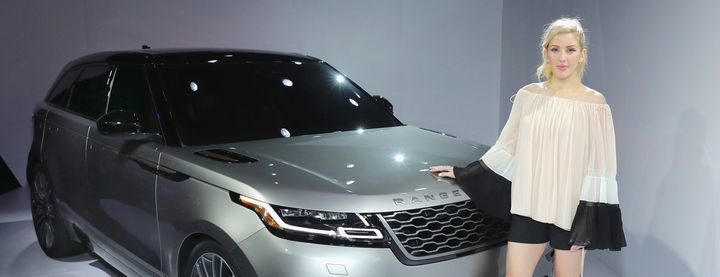
Pop balladeer Ellie Goulding rests a hand on a new Range Rover Velar. photo: Jaguar Land Rover
Nifty technology features include “InControl Remote,” an app that allows drivers to use their smartphones to remotely start the engine, adjust climate settings, lock and unlock the vehicle, and map routes.
Unique to the Velar are optional “Connect Pro services,” which include a 4G Wi-Fi Hotspot and “Share ETA,” which enables drivers to share arrival times with selected contacts via texts or email. “Single-tap” satellite and street-level views are also available on front and rear-seat touchscreens.
Go Huge or Don’t Go at All
The all-new Lincoln Navigator, while 200 pounds lighter than its antecedent, is still gargantuan, at nearly 3 tons. Yet, despite its hulking nature, the exterior neatly fuses elegance and menace. The inside features a dozen power outlets among its three rows of seats, so all passengers (it easily fits eight) can keep their smartphones charged. A 450 HP twin-turbo V6 engine tied to a 10-speed transmission gets this mammoth down the road.
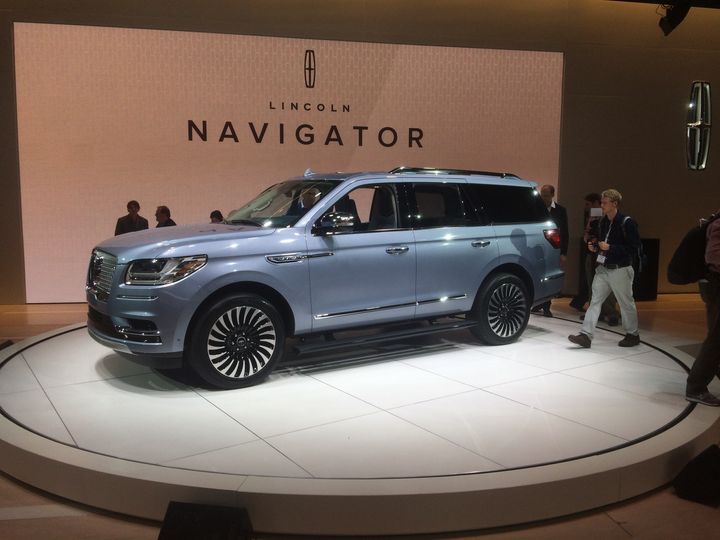
The elegant menace of the all-new 2018 Lincoln Navigator. photo: Shane Kite
Subaru showed off a seven-seater concept version of its new three-row SUV, which will be called the Ascent once it goes into production later this year. Expect this truck to be powered by a new turbocharged direct-injection boxer engine.
Known for its popular wagons, the Japanese automaker gave the low-slung SUV a front fascia with a more serious, growly demeanor than is typical for historically unassuming Subies.
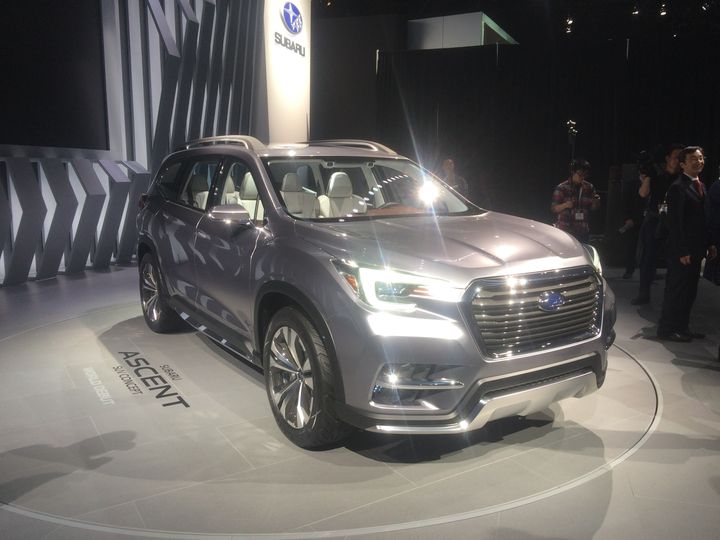
Subaru will offer a three-row SUV called Ascent, based on this concept. photo: Shane Kite
A fully redesigned Crosstrek, the second Subaru vehicle built on Subaru’s new global platform, had its U.S. premiere, showing improved versatility via a larger cargo space and higher ground clearance - a goodly 8.7 inches. So now drivers have more room to stow gear and safely cover stony, uneven ground in the compact SUV during backcountry getaways. Plus, it’s available in tangerine.
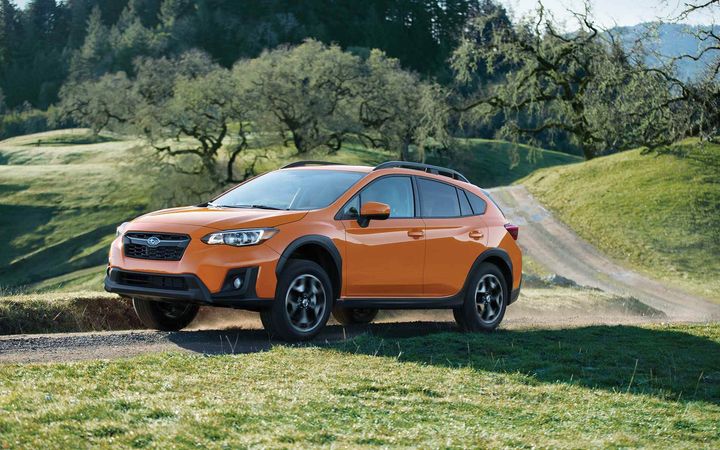
A tangerine 2018 Subaru Crosstrek crossover in its natural habitat. photo: Subaru
SUV or Wagon?
Mercedes’ new luxury SUV - the overly rhyme-y AMG GLC 63 - had its world premiere in New York. The 469 HP V8 “Biturbo” 4-liter engine propels this snazzy crossover from nothing to 60 mph in 3.9 seconds. Yet it was hard to tell at first if we were looking at the new Mercedes SUV, or the just-as-zippy E63 wagon, which was at Javits making its North American debut. It’s the converging rendering, line diversity dilemma faced by all automakers in these two niches: Designers are increasingly shrinking SUVs to look more like wagons, while boosting wagons to resemble crossovers.
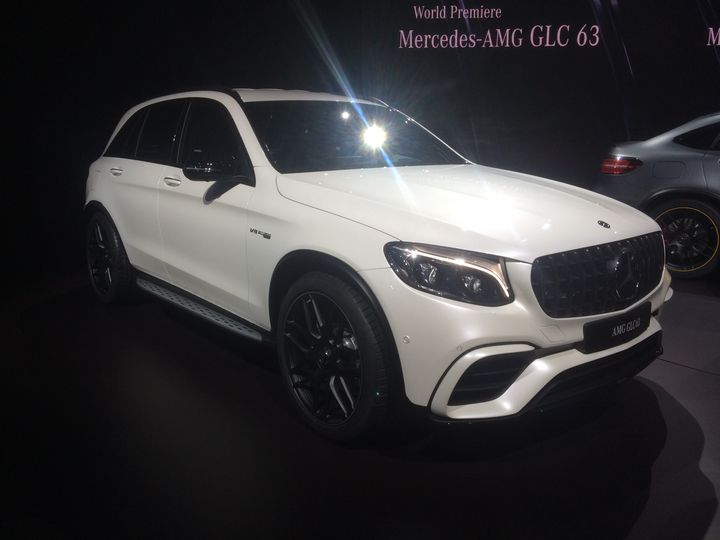
Low-slung SUV from Mercedes: The AMG GLC 63. photo: Shane Kite
Last but certainly not least in the SUV segment: Behold the Infiniti QX80 Monograph Concept, a design study meant to fully entrench Nissan’s lux division into the full-size SUV market.
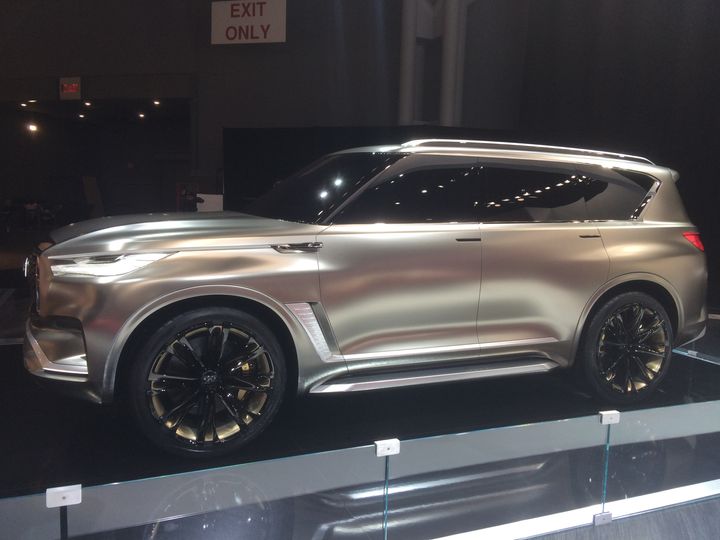
The Infiniti QX80 Monograph design concept SUV from Nissan’s lux division. photo: Shane Kite
The press photo of the QX80 that careened out of our ink-jet printer didn’t do this beguiling, “Gruffalo”-like gem justice. The dull image we were forced to preview evoked “old boot” more than “prowling, high-end SUV.” But we were mesmerized when seeing this behemoth up close and in person. We couldn’t stop photographing it: From every angle, this louring, inscrutable performance piece enchanted: Love the sharkskinned sheen, scuba-fin side mirrors, and frowning front and rear fascias. Those bitchy resting faces give this well-coifed, urbane SUV a dogged, churlish charm, like a courtly angler fish dressed for dinner. Or maybe like all design concepts meant to inspire change, it’s just fun to dream.
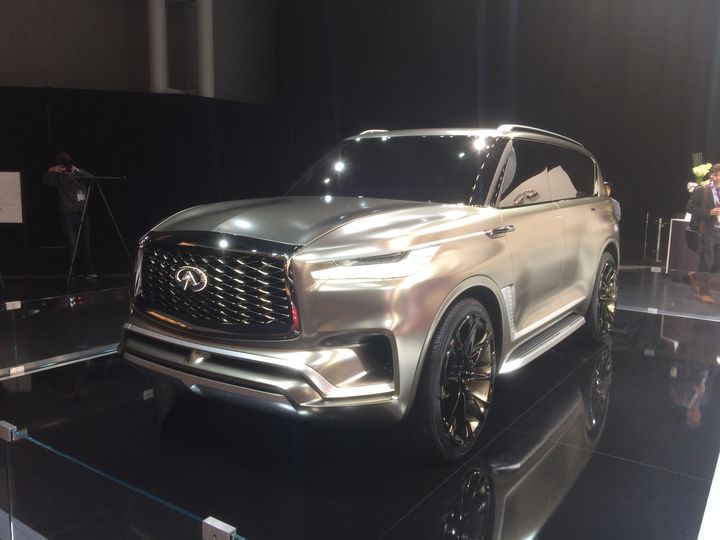
photo: Shane Kite
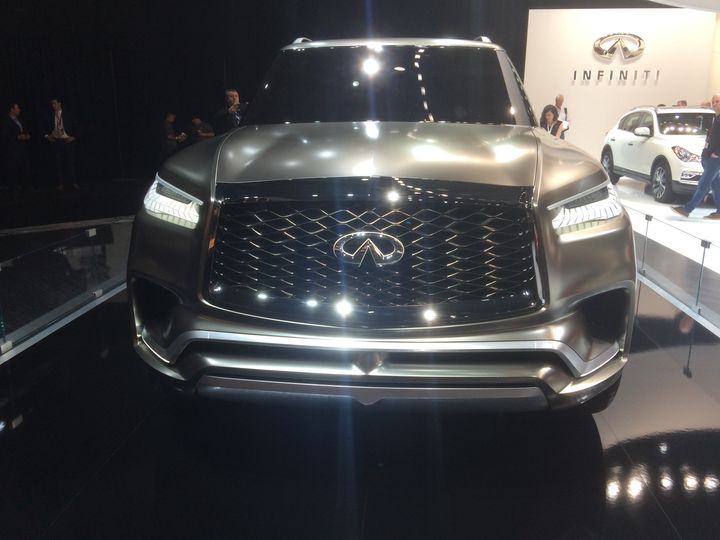
photo: Shane Kite
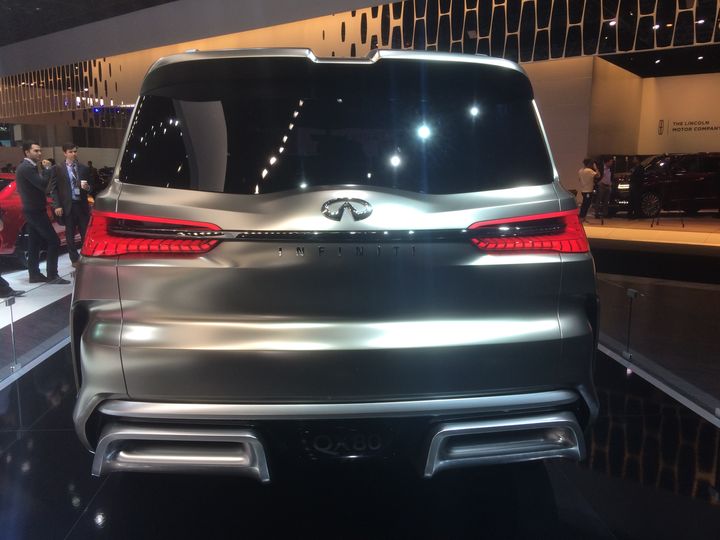
photo: Shane Kite
Sports Cars, Coupes and Racing Loops
Imagine a muscle car so explosively responsive that stomping on the accelerator makes it pop a three-foot wheelie. That’s what happened during a test of the Dodge Challenger SRT Demon: It produced the first-ever wheelie recorded for a production car, according to Dodge. The division of FCA U.S. certified the 2.92-foot lift as a Guinness World Record.
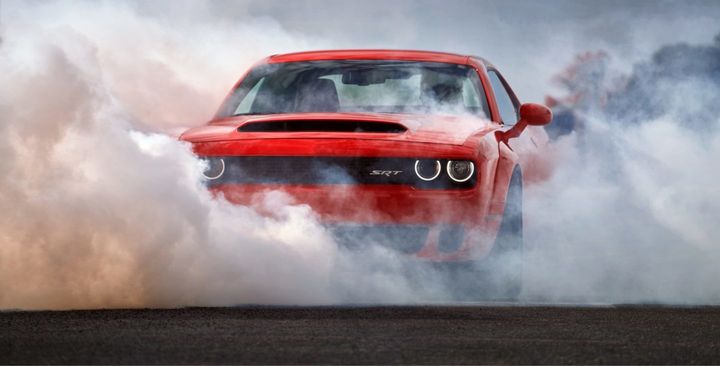
Smoking tires accompany the launch of this Dodge Challenger SRT Demon. photo: Dodge
Enabling that trick inside this track-devouring monster is a truly demonic, supercharged, 6.2-liter HEMI Demon V-8. The earth-scorching engine generates 840 horsepower and produces 770 lb-ft of torque: the most-powerful muscle car ever produced.
The bedeviled hot rod is also the world's fastest production car, taking a mere 2.3 seconds to go from zero to 60 mph.
"Our goal was to build a car that would tattoo the Dodge logo into the subconscious of the general market, beyond even our loyal enthusiasts,” said Tim Kuniskis, head of passenger cars for Dodge, SRT, Chrysler, FIAT and FCA North America.
We’re betting a fair amount of committed superfans have already tattooed replicas of the Challenger’s laughing demon badge on various epidermal surfaces. Committed is right.
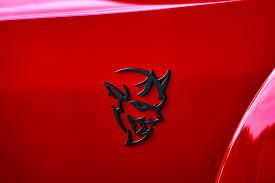
We predict fans will get tattoos of the Challenger demon badge because it’s so darn awesome. photo: Shane Kite
Porsche brought four North American debuts to New York this year: The 911 GT3, the 911 GTS, the Panamera Sport Turismo, and the Panamera Turbo S E-Hybrid.
The new, motorsport-based 500 horsepower 911 GT3 is powered by a naturally aspirated 4-liter flat-six that revs to 9,000 rpm and generates 339 lb.-ft. of torque. A six-speed manual transmission is available as a free alternative to the seven-speed dual-clutch. The new, high-revving power plant is based on the one now used in 911 race cars, including the 911 GT3 R and 911 RSR. The 3,153-pound two-seater accelerates to 60 mph in 3.2 seconds and has a top track speed of 197 miles per hour. Expected to reach U.S. dealers in fall of 2017, the base MSRP is $143,600, excluding a $1,050 delivery, processing, and handling fee.
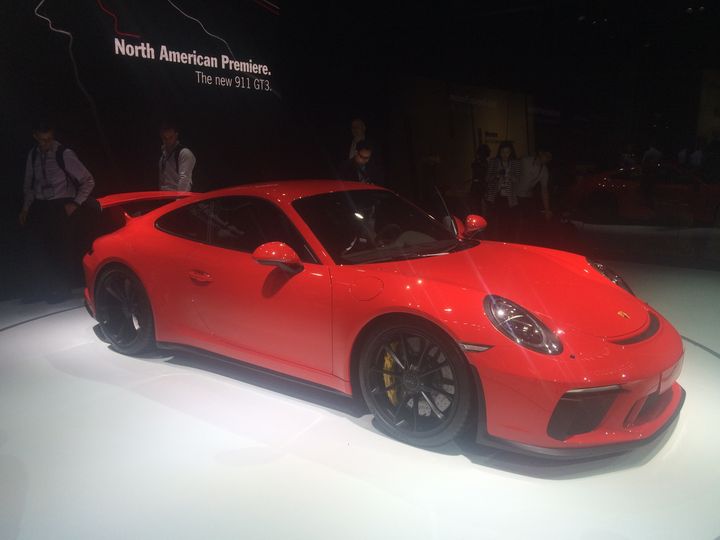
New 911 GT3. photo: Shane Kite
There are five new 911 GTS models, which represent the highest performing 911 Carrera and Targa variants. And each come with a higher level of standard equipment and several performance enhancing features. The 911 Carrera GTS is rear-wheel drive and the 911 Carrera 4 GTS is all-wheel, although both are available as a Coupe and Cabriolet; while the 911 Targa 4 GTS arrives with all-wheel drive. The 3-liter flat-six cylinder gets larger turbochargers and generates 450 horsepower - 30 HP more than the current 911 Carrera S and 20 HP above the prior, naturally-aspirated GTS model. The 911 GTS produces 405 lb.-ft. of torque – 37 lb.-ft. more than the Carrera S – which upgrades acceleration and responsiveness. Max torque is available between 2,150 and 5,000 rpm. Porsche Active Suspension Management (PASM) is included as standard on all GTS models. A seven-speed manual transmission is standard on all variants, while a seven-speed PDK dual-clutch transmission is available as an option.
The 2018 911 GTS models are scheduled to arrive at dealers this month. Suggested retail prices start at $120,700 for the 911 GTS, $127,600 for the 911 Carrera 4 GTS, $133,000 for the 911 Carrera GTS Cabriolet, $139,900 for the 911 Carrera 4 GTS Cabriolet, and $139,900 for the 911 Targa 4 GTS. All prices exclude a $1,050 delivery, processing, and handling fee.
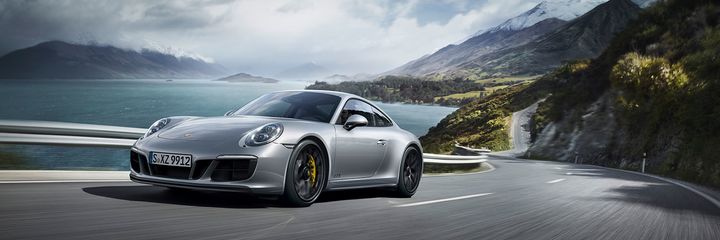
The Porsche Carrera 4 GTS with PDK transmission gets to 60 mph in 3.4 seconds. photo: Porsche
The five-seater Panamera Sport Turismo features a larger tailgate and luggage compartment, an upgrade to the practicality of this luxury wagon known for premium performance. Four models will be available with corresponding four engines from the sport sedan. Powered by a 4-liter twin-turbocharged V8, the 550 horsepower Panamera Turbo Sport Turismo reaches 60 mph via the help of “launch control,” a computerized electronic accelerator, in 3.4 seconds. The Panamera 4S Sport Turismo gets to 60 mph with launch control in 4 seconds, and is powered by a 440 horsepower, 2.9 liter twin-turbocharged V6 engine. The Panamera 4 E-Hybrid Sport Turismo has the same combustion engine as the 4S, but has an additional 136-hp electric motor. The combination propels the hybrid to 60 mph in 4.4 seconds. The Panamera 4 Sport Turismo’s 3-liter, turbocharged V6 generates 330 horsepower, and reaches 60 mph in 5 seconds with launch control.
Expected at dealers by yearend, suggested retail prices will start at $96,200 for the Panamera 4 Sport Turismo, $104,000 for the Panamera 4 E-Hybrid Sport Turismo, $109,200 for the Panamera 4S Sport Turismo, and $154,000 for the Panamera Turbo Sport Turismo. That excludes the $1,050 delivery, processing, and handling fee in each case.
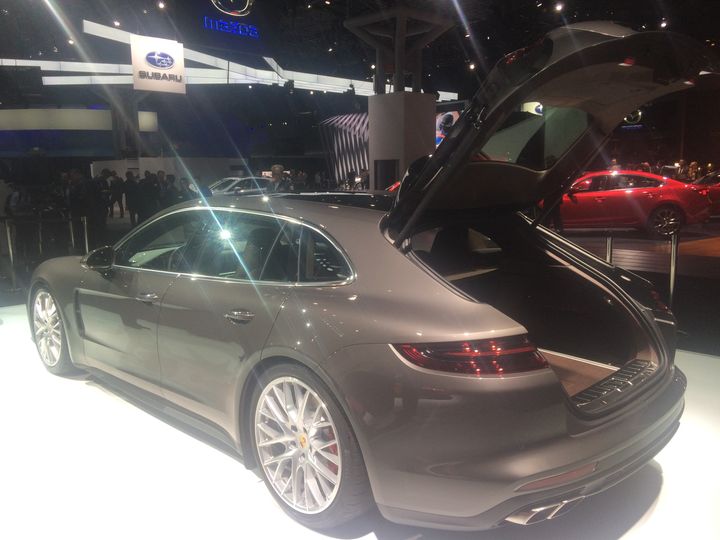
Porsche’s Panamera Sport Turismo wagon. photo: Shane Kite
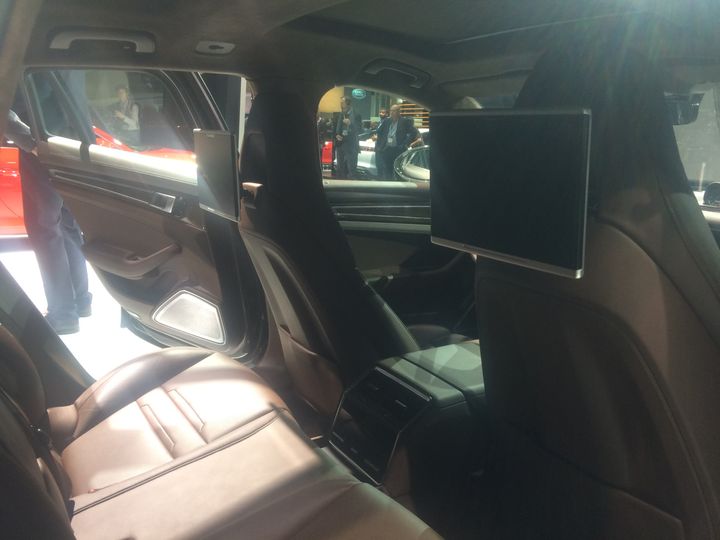
The Panorama wagon’s rear seat infotainment screens, now ubiquitous in the lux segment. photo: Shane Kite
The new plug-in Panamera Turbo S E-Hybrid sedans represent the most powerful Panamera models ever made. Mixing a 4.0-liter V8 engine from the Panamera Turbo with an electric motor, the Hybrid delivers a whopping 680 horsepower and 626 lb.-ft. of torque. An “Executive” version will be offered with a longer, 5.9-inch wheelbase. Expected at dealerships by yearend, the base suggested retail price for the Turbo S E-Hybrid sedan will be $184,400, while the Executive will start at $194,800. Those prices exclude the $1,050 delivery, processing and handling fee. The powerful sedans mark the first time Porsche has positioned a plug-in hybrid as the highest-performing variant of a standard line.
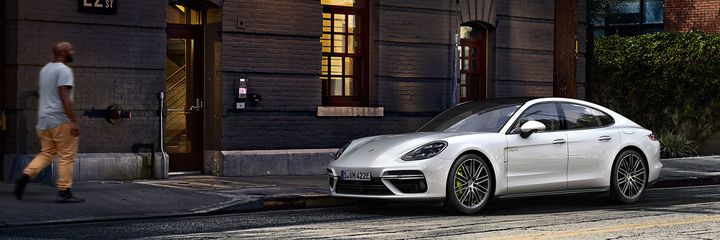
Blazing fast Panamera Turbo S E-Hybrid sedan at rest. photo: Porsche
Mercedes held the global unveiling of its new AMG GLC 63 coupe, which carries the same engine specs as the SUV, and like its bigger sibling, is available in a more robust S version that generates 503 horsepower.
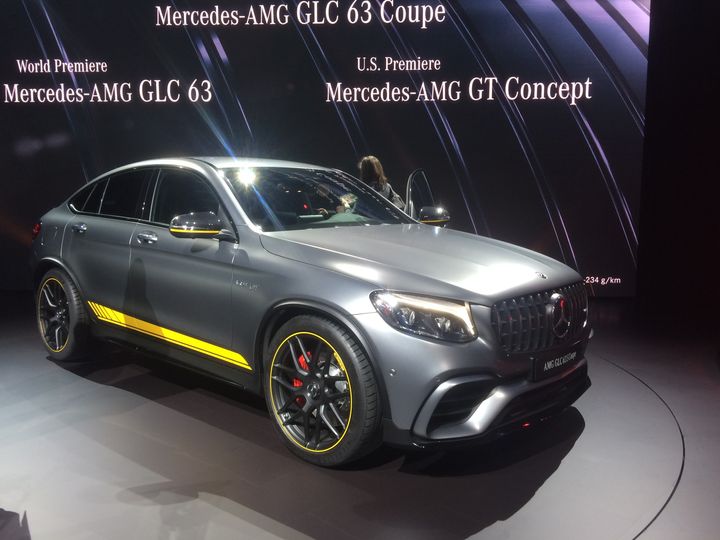
Attendee finishes a looksie at the interior of Mercedes new GLC 63 coupe. photo: Shane Kite
The Mercedes-AMG GT Concept also made its debut, adding a supercar-strength hybrid drive to the German automaker’s sports car brand. The system mixes a highly efficient V8 petrol engine with a powerful electric motor and modular battery design that generates up to 816 hp. The concept accelerates to 60 mph in less than three seconds. The aim of the GT Concept, Mercedes says, is to combine performance with everyday usability; hence the sizable tailgate and flexible interior and luggage space. The four-door coupe is slick, with a kicked back cabin to make room for an impressive engine.

Mercedes winsome hybrid supercar concept gets DJ serenade. photo: Shane Kite
Lexus revealed to the world its hybrid full-size luxury sedan, the LS 500 F Sport. The all-new 3.5-liter V6 engine with twin turbochargers is paired with, Lexus says, the first-ever 10-speed automatic transmission for a luxury sedan. The F Sport produces 415 horsepower and 442 lb-ft of torque and gets to 60 mph in 4.5 seconds (in gas-fueled rear-wheel drive). An electric “wastegate” was added to enable rapid engine response. Drivers can also choose from Normal, Sport S, or Sport S+ modes, which sonically modifies the exhaust note.
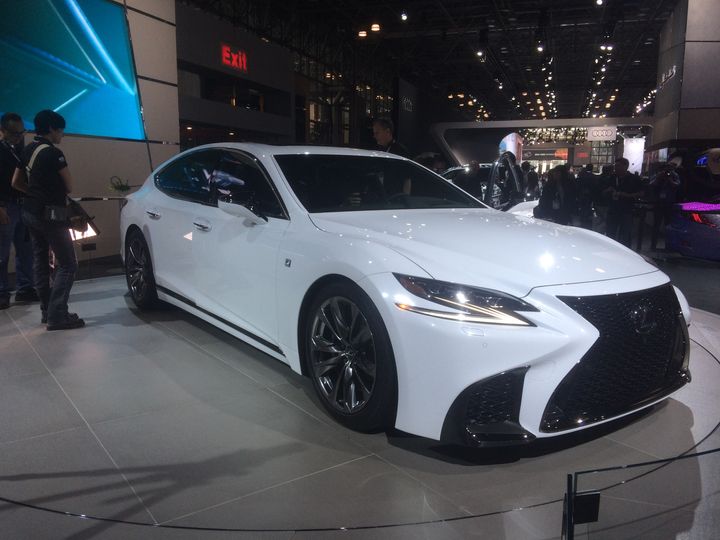
The Lexus LS 500 F Sport. photo: Shane Kite
The Audi RS 3 had its North American debut, showcasing some devilishly clever features. The all-new 2.5-liter engine paired with a seven-speed S tronic dual clutch transmission generates 400 horsepower. Maximum torque of 354 lb-ft arrives at engine speeds as low as 1,700 rpm. and remains constant up to 5,850 rpm. The RS 3 achieves a 0-60-mph sprint of 3.9 seconds, and owns a 155-mph top track speed. Those wanting more top-end quickness can get to 174-mph by tapping a “Dynamic plus” package.
Besides launch control, the five-cylinder produces a distinct engine note that can be controlled by opening the flaps of the standard RS exhaust system. Additionally, a new dual-injection fuel system uses “intelligent engine management control” to optimize fuel injection and distribution based on engine load.
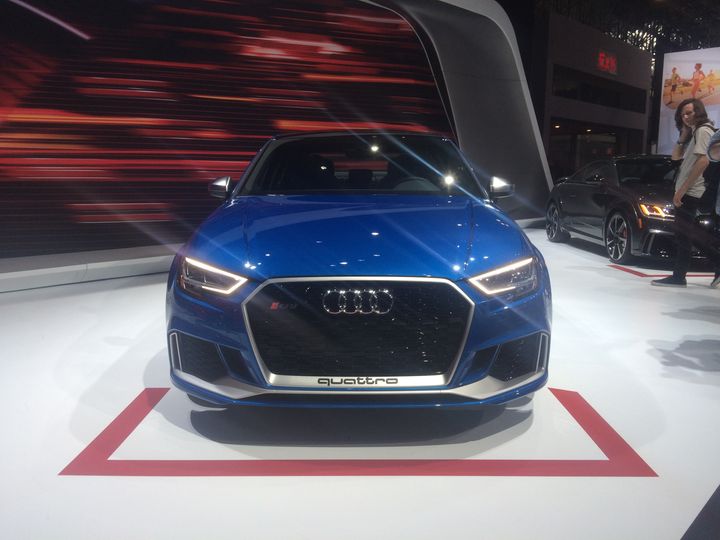
The Audi RS3 makes is N. American debut. photo: Shane Kite
Now go see some cars!
